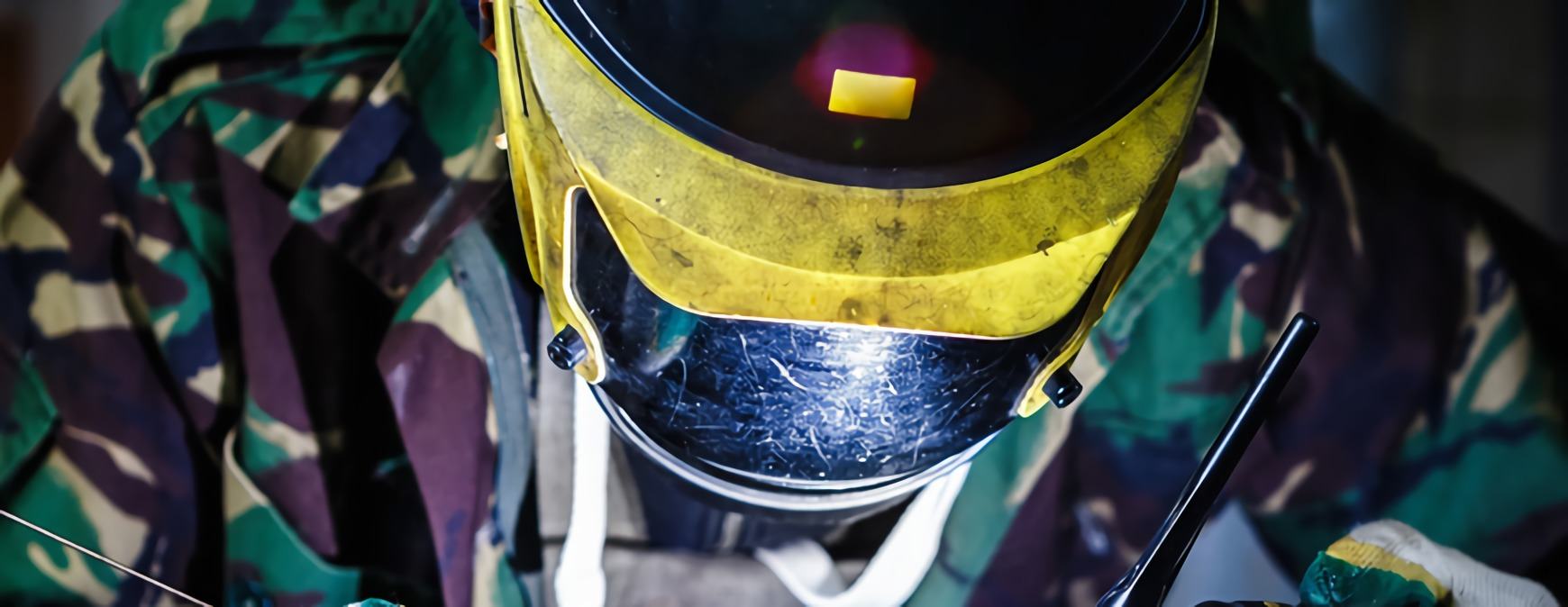TWS is a Great Training Option for Everyone
Learn more about how we can prepare you to advance your career.
Part of the welding gear when starting welding training is the welding helmet. Selecting the right welding helmet will not only keep a welder safe and comfortable on the shop floor but also improve productivity and the quality of the welds. Here are some factors to consider when choosing a welding helmet. 1
How Do Welding Helmets Work?
Arc welding produces three types of light that can damage a welder’s eyes: ultraviolet, infrared, and visible. 2 Welders are also at risk of burns from sparks and hot molten metal. A welding helmet is designed to protect a welder’s face and eyes from these dangers. 3
The most basic helmets are composed of a nonflammable face shield that attaches to the welder’s head with an adjustable strap. A rectangle is cut out of the shield where a welder’s eyes would be. Within this rectangle is a lens covered by a protective screen. The lens is coated and darkened to protect the welder’s eyes from the various types of harmful light the arc emits. The higher the shade level, the darker it is and the more light it filters. 4
One of the first things to check when selecting a welding helmet is that the American National Standards Institute (ANSI) has tested and approved it. This will ensure the helmet keeps you safe. Look for ANSI Z87.1 for face and eye protection.
Have You Considered a Career in the Skilled Trades?
Fill out the form to recieve a no obligation info packet.
What Types of Welding Helmets Are There?
Over the years, more complex welding helmets have been developed. While these helmets offer more features that can provide greater protection, convenience, and comfort, they also tend to be more expensive. 5 Below are some of the common helmet options available to welders today.
Helmet Weight
The heavier the welding helmet, the greater the strain you could feel in your neck. If you’ll be welding for several hours at a time, a heavy one could be uncomfortable or painful. Welding helmets with plastic shells tend to be lighter. A hood with multiple and/or pivot-style bands can displace the weight of the helmet and secure it better to the head which is more comfortable. 6 A major advantage to the lighter helmet is a lessened risk of work-related stress injuries over time. 7 However, lighter helmets are more expensive. 8
Passive Lenses
Also called “standard lenses,” passive lenses come in one shade. In order to see the work and properly position a welding torch, electrode, or gun, the welder wears the helmet in the up position away from his or her face. Right before striking the arc, the welder snaps his or her neck to flip the helmet into the proper position to shield the face and eyes.
Passive lenses have been providing sufficient protection to welders for years, and they tend to cost less than auto-darkening lenses. However, as welders have to flip passive helmets into place, they’re not the most ergonomic option and can cause neck pain. Also, if the welder doesn’t snap the hood into place at the right time, his or her eyes may be exposed to harmful light. Inexperienced welders may not be able to hold the electrode in place while flipping the helmet down, resulting in poor or even defective welds.
Auto-Darkening Lenses
As the name suggests, auto-darkening lenses change shades to fit the welder’s needs. When the welder needs to see the work, sensors in the hood lighten the shade of the lens to a lower level. These same sensors detect when the welder strikes the arc and darken the lens to a higher one depending on the process.
An advantage to auto-darkening lenses is welders don’t need to flip the helmet into place once the arc is struck. These types of welding hoods tend to be more comfortable and allow the welder to produce better quality work. However, auto-darkening lenses are often more expensive. 9 10 Welders who start out working with an auto-darkening hood may find it difficult to weld with a passive one in the future. 11
Additional Considerations: Auto-darkening helmets come with various shading and sensor options. Essentially, the more sensors and shades a helmet has, the greater the range of work a welder can perform safely. 12
Which Welding Helmet Is Best?
As with other welding safety equipment, there a several considerations when selecting a welding helmet. When weighing the options, think about the length of time wearing the hood, the types of welding jobs, and finances. 13 While it might be nice to have a welding helmet with all the bells and whistles, it might not always be necessary.
1 – https://www.millerwelds.com/resources/article-library/selecting-the-right-welding-helmet-for-you
2 – Title: Welding Principles and Applications; Author: Larry Jeffus; Delmar Cengage Learning; Seventh Edition; Textbook page 25-27
3 – http://weldinghelmetexpert.com/what-you-need-to-know-before-purchasing-a-welding-helmet/
4 – https://www.osha.gov/Publications/OSHAfactsheet-eyeprotection-during-welding.pdf
5 – https://www.bakersgas.com/how-choose-welding-helmet.php
6 – http://www.lincolnelectric.com/en-us/support/welding-how-to/Pages/welding-helmet-selection.aspx
7 – http://www.lincolnelectric.com/en-us/support/welding-how-to/Pages/welding-helmet-selection.aspx
8 – http://www.lincolnelectric.com/en-us/support/welding-how-to/Pages/welding-helmet-selection.aspx
9 – https://www.millerwelds.com/resources/article-library/selecting-the-right-welding-helmet-for-you
10 – http://weldinghelmetexpert.com/what-you-need-to-know-before-purchasing-a-welding-helmet/
11 – https://www.bakersgas.com/how-choose-welding-helmet.php
12 – https://www.bakersgas.com/how-choose-welding-helmet.php
13 – http://www.lincolnelectric.com/en-us/support/welding-how-to/Pages/welding-helmet-selection.aspx
This blog has been labeled as archived as it may no longer contain the most up-to-date data. For a list of all current blog posts, please visit our blog homepage at https://www.tws.edu/blog/







